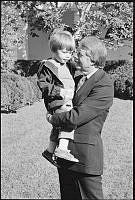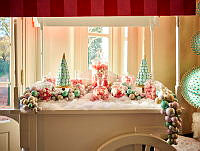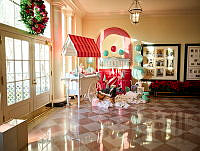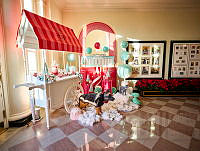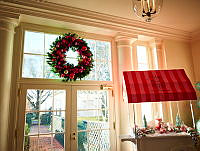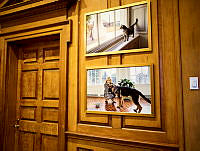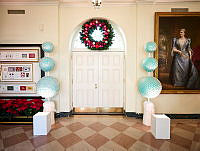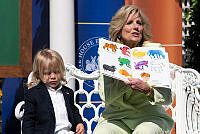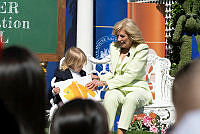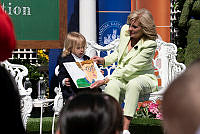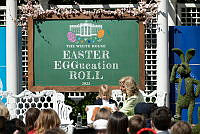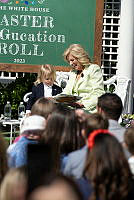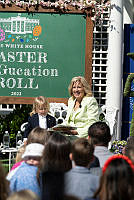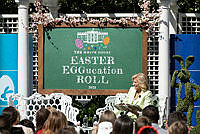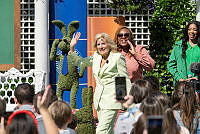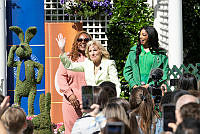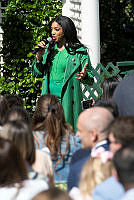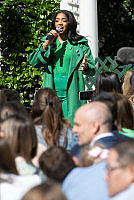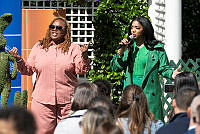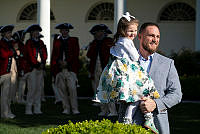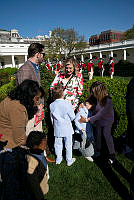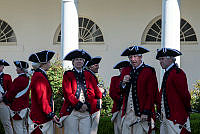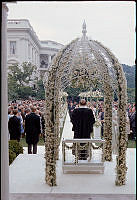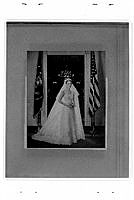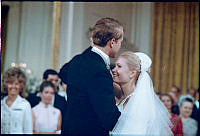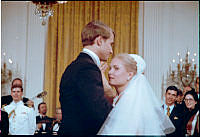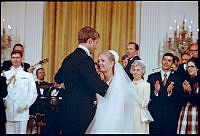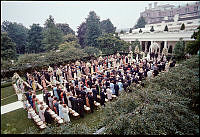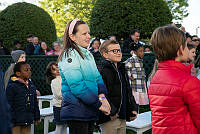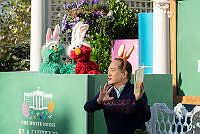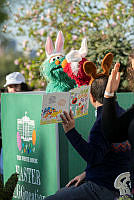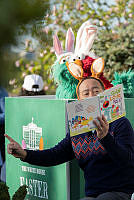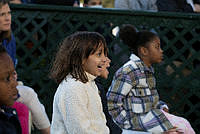TEACHER'S TEXT:
Why wait until February to learn about the history-making decisions of America’s most recognized leader? Since George Washington essentially invented the office of the president in the 1790s, the nation’s chief executive has rarely stayed on the sidelines when major events unfold. The westward movement, race relations, war, and space exploration are just a few of the topics that young students can examine by learning how these events transpired through the leadership of the president. In essence, you can put a face on history.
The White House is an office, the president’s office. It is where the chief executive and commander in chief does the business of the people. Through two centuries, some of the most critical moments in United States’ history have evolved inside the nation’s most famous building. In this lesson, we explore some of them.
Download Lesson Plan
Download Activities
Objectives
By successfully completing this lesson and accompanying activities, students will:
- Recognize the role of the president in shaping American history.
- Understand that the White House is the office of the president, and a place where important decisions have been made that have affected the path our nation has taken.
- Explore how an individual can make a difference in a democratic society.
National Standards for History
The content and activities in "Every Day is Presidents’ Day at the White House" comply with the National Standards for History for Grades K-4, as developed by the National Center for History in the Schools, Los Angeles, CA.
Topic 3 The History of the United States: Democratic Principles and Values and the People from Many Cultures Who Contributed to Its Cultural, Economic, and Political Heritage
Standard 4C The student understands historic figures who have exemplified values and principles of American democracy.
LESSON PLAN:
What Does the President Do?
Every four years, Americans decide who will live and work in the White House. They vote for the president of the United States. For one person, the president has a lot of power. He also has much responsibility. What does the president do?
- He makes sure that citizens obey laws.
- He is in charge of all armed forces.
- He makes agreements, called treaties, with other countries.
- He decides how America will act toward other countries and he represents our country here and around the world.
- When Congress sends him a new law, he may or may not agree to sign it.
- He lets Congress know about new laws he thinks should be passed.
Since so much power is given to one person, we hope that the president is a good leader. We hope that he uses his power to make the lives of Americans better.
Where Does the President Work?
Do you know anyone who works at home? Many people do. The president works in his home, the White House. In the White House, the president has an office. It is called the Oval Office. In over two hundred years, 43 presidents have worked in the White House. They have made important decisions from the house at 1600 Pennsylvania Avenue in Washington, D.C.
Let’s meet some of the presidents and learn about the important work they have done in the White House.
Thomas Jefferson, 3rd President, 1801-1809
Lewis and Clark Explore the West
Thomas Jefferson’s office was part of the room that is now called the State Dining Room. He had a long worktable with drawers on both sides. On the walls he put maps. He also had globes and lots of paper for writing. Jefferson’s pet mockingbird lived in a cage in his office, but sometimes the bird flew around the room. Jefferson could see the Potomac River when he looked out his windows.
Jefferson’s office was very private. It was a place for working and learning. The office was also called a "library." Who learned in his office? Jefferson, of course. But Jefferson also taught a 27-year-old student named Meriwether Lewis. Lewis was Jefferson’s secretary, but he did not write many letters. Jefferson hired Lewis because he knew how to live outdoors. Jefferson wanted Lewis to explore the western lands that the president had purchased for America. The Louisiana Purchase gave the United States millions of acres west of the Mississippi River. No one really knew how much land was out there or who lived there.
Jefferson taught Lewis about plants and animals. He taught him math and surveying, too, so Lewis could make maps of the new land. Meriwether Lewis and his friend William Clark explored the west. They sent Jefferson some of the things they found: stuffed animals, antlers, Indian costumes, plants, and snakeskins. Jefferson put these things in the White House and invited people to come see them and learn about the new land. He wanted Americans to be excited about their growing country.
Abraham Lincoln, 16th President, 1861-1865
The Emancipation Proclamation
One of the most important jobs of a president is to write and sign his name on papers, called documents. One of the most important documents ever written by a president is called the Emancipation Proclamation. It was signed by President Abraham Lincoln in his White House office on January 1, 1863. Emancipation means being free. Proclamation is a way of telling people something. Abraham Lincoln was telling people that the slaves were free. He wrote the paper and signed it during the Civil War.
January 1, 1863 was New Year’s Day. On New Year’s Day, the White House was open to anyone who wanted to meet the president and his wife. Abraham Lincoln shook hands with visitors all morning. Then he walked upstairs to the second floor of the White House. He took his pen and signed his name at the bottom of the Emancipation Proclamation. His hand was wobbly when he signed it. This was a very powerful thing to do. It meant that the Civil War was a fight for freedom. The freedom of black slaves. It meant that our country stood for freedom for Americans whether they were black or white. Sometimes, a president can make very big decisions that will make life better for Americans. This is what Abraham Lincoln did when he wrote the Emancipation Proclamation.
Woodrow Wilson, 28th President, 1913-1921
Helping American Soldiers
In 1917, President Woodrow Wilson sent American troops to fight in World War I. He said that the world must "be made safe for democracy." In a democracy, all the people decide who will have power. Wilson wanted to make sure that if a country wanted to be a democracy, another nation would not stop them.
When the United States goes to war, Americans support the men and women who fight for us. One way to help our soldiers is to sacrifice, or give up, some things we eat or buy. The food we save or the clothes we don’t buy can be sent to the soldiers who are fighting far away from home.
Good leaders set good examples. President Wilson thought he should set an example, so he planted a vegetable garden at the White House. Instead of buying vegetables, the Wilson family ate what they grew in the White House garden. President Wilson also had sheep in his yard! The sheep’s wool was sold and the money was used to help pay for army hospitals. President Wilson showed Americans that they should sacrifice, too.
John F. Kennedy, 35th President, 1961-1963 and Richard Nixon, 37th President, 1969-1973
Putting a Man on the Moon
The United States was a very proud country when American astronauts first stepped on the moon on July 20, 1969. How did this happen? President John Kennedy wanted America to be the first country to have a man reach the moon. He wanted to show that American scientists were the best in the world. With presidents leading the way, it finally happened, but it took eight years.
President Richard Nixon spoke to the first astronauts on the moon. "Hello, Neil and Buzz," he said. "I’m talking to you by telephone from the Oval Room at the White House." President Nixon was speaking to Apollo 11 Commander Neil Armstrong and Pilot "Buzz" Aldrin. Half a billion people around the world watched on television as Armstrong stepped on the surface of the moon. More Apollo spacecraft would fly to the moon over the next three years. Now, American probes have gone to the planet Mars. A probe is a spacecraft that flies with no humans on board. A probe takes samples of soil and rock and other information from planets and outer space.
It takes many men and women working together to send a spacecraft, probe, or shuttle to space. They can do great things if they think their leader is supporting them. America’s trips to space were successful because presidents thought they were important and would teach us about the Earth’s neighbors in space.


















